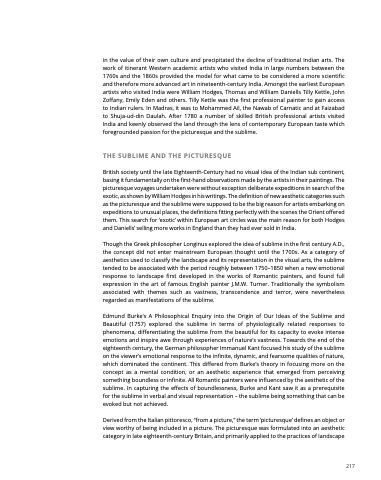Page 223 - Eye of the beholder
P. 223
in in the the the value of of their own culture and precipitated the the the decline of of traditional Indian arts The work of itinerant Western academic artists who visited India in in large numbers between the 1760s and the the 1860s provided the the model for what came to be considered a a a a more scientific and therefore more advanced art in in nineteenth-century India Amongst the the earliest European artists who visited India were William William Hodges Thomas and William William Daniells Tilly Kettle John Zoffany Emily Eden and others Tilly Kettle was the the first professional painter to gain access to to Indian rulers In In Madras it was to to Mohammed Ail the Nawab of Carnatic and at at Faizabad to Shuja-ud-din Daulah After 1780 a a a a a a number of of skilled British professional artists visited India and and keenly observed the the land through the the lens of contemporary European taste which foregrounded passion for for the the picturesque and the the sublime THE THE SUBLIME AND THE THE PICTURESQUE
British society until the the late Eighteenth-Century had no visual idea of the the Indian sub continent basing it fundamentally on on the the the first-hand observations made by the the the artists in in in in their paintings The picturesque voyages undertaken were without exception deliberate expeditions in search of the exotic as shown by William Hodges in in fin his writings The definition of new aesthetic categories such as as the the the picturesque and the the the sublime were supposed to be the the the big reason for artists embarking on on expeditions to unusual places the the the definitions fitting perfectly with the the the scenes the the the Orient offered them This search for for ‘exotic’ within European art circles was the the main reason for for both Hodges and and Daniells’ selling more works in in in England than they had ever sold in in in India Though the the the Greek philosopher Longinus explored the the the idea of sublime in in the the the first century A D the the concept did not enter mainstream European thought until the the 1700s As a a a a a category of aesthetics used to classify the the the the landscape and and its representation in the the the the visual arts the the the the sublime tended to be be associated with the period roughly between 1750–1850 when a a a a new emotional response to landscape first developed in in the works of Romantic painters and and found full expression in in the the art of famous English painter J M W Turner Traditionally the the symbolism associated with themes such as as as vastness transcendence and terror were nevertheless regarded as manifestations of the sublime Edmund Burke’s A Philosophical Enquiry into the the Origin of of Our Ideas of of the the Sublime and Beautiful (1757) explored the sublime in terms of physiologically related responses to phenomena differentiating the the sublime from the the beautiful for its capacity to evoke intense emotions and inspire awe through experiences of of nature’s vastness Towards the the end of of the the eighteenth century the the German philosopher Immanuel Kant focused his study of the the sublime on on on the the viewer’s emotional response to the the infinite dynamic and fearsome qualities of nature which dominated the the the continent This differed from Burke’s theory in in in in focusing more on on the the the concept as a a a a a a mental condition or an aesthetic experience that emerged from perceiving something boundless or infinite All Romantic painters were influenced by the the the aesthetic of the the the sublime In capturing the effects of boundlessness Burke and Kant saw it it as a a a a a a prerequisite for the the sublime sublime in in in verbal and visual representation – the the sublime sublime being something that can be be evoked but not achieved Derived from from the the Italian pittoresco “from a a a a picture picture ” the the term ‘picturesque’ defines an an object or or view worthy of being included in in in in a a a a a picture picture The picturesque was formulated into an aesthetic category in in late eighteenth-century Britain and and primarily applied to the practices of landscape 217


